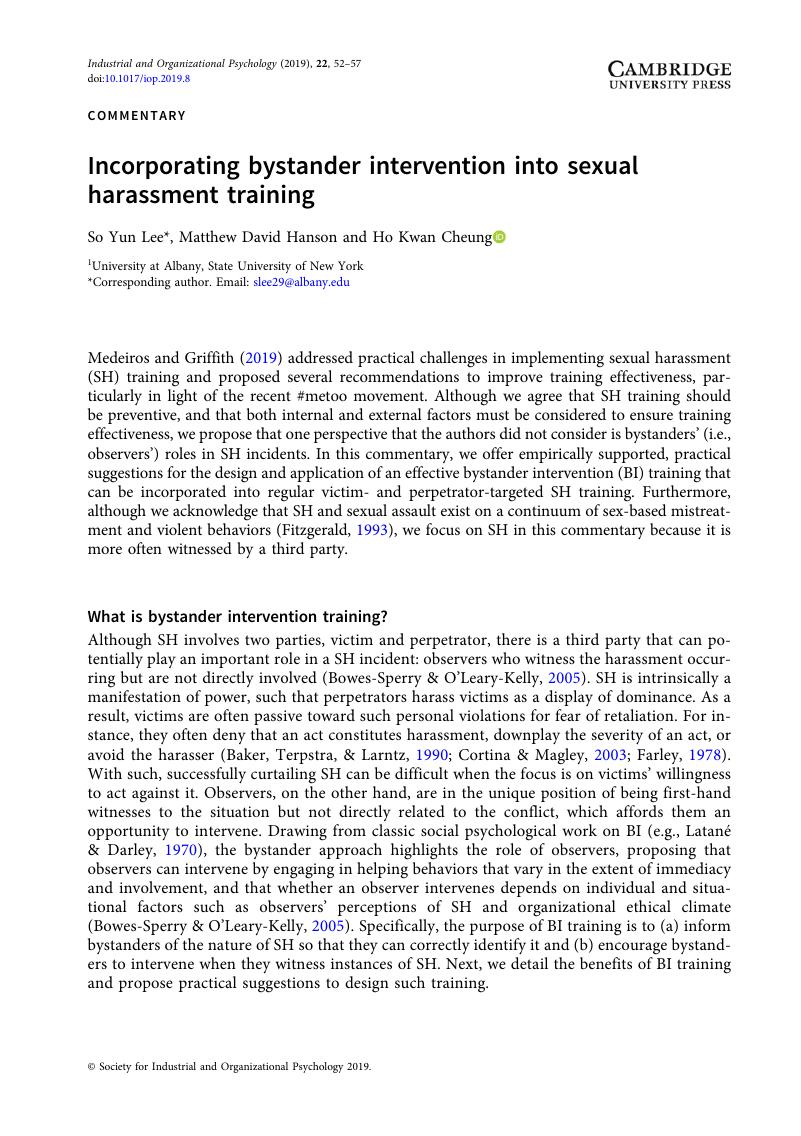Crossref Citations
This article has been cited by the following publications. This list is generated based on data provided by Crossref.
Zelin, Alexandra I.
and
Magley, Vicki J.
2020.
Handbook of Interpersonal Violence and Abuse Across the Lifespan.
p.
1.
Perry, Sara Jansen
2020.
Changing the narrative on harassment and discrimination training: Building an organizational culture with healthy professional boundaries.
Industrial and Organizational Psychology,
Vol. 13,
Issue. 2,
p.
186.
Fenwick, Karissa M.
Luger, Tana M.
Dyer, Karen E.
Chrystal, Joya G.
Hamilton, Alison B.
Yano, Elizabeth M.
and
Klap, Ruth
2021.
Challenges to Addressing Patient-Perpetrated Sexual Harassment in Veterans Affairs Healthcare Settings.
Journal of General Internal Medicine,
Vol. 36,
Issue. 8,
p.
2332.
Fenwick, Karissa M.
Potter, Sharyn J.
Klap, Ruth
Dyer, Karen E.
Relyea, Mark R.
Yano, Elizabeth M.
Luger, Tana M.
Bergman, Alicia A.
Chrystal, Joya G.
and
Hamilton, Alison B.
2021.
Staff and Patient Perspectives on Bystander Intervention Training to Address Patient-Initiated Sexual Harassment in Veterans Affairs Healthcare Settings.
Women's Health Issues,
Vol. 31,
Issue. 6,
p.
576.
Gruber, June
Mendle, Jane
Lindquist, Kristen A.
Schmader, Toni
Clark, Lee Anna
Bliss-Moreau, Eliza
Akinola, Modupe
Atlas, Lauren
Barch, Deanna M.
Barrett, Lisa Feldman
Borelli, Jessica L.
Brannon, Tiffany N.
Bunge, Silvia A.
Campos, Belinda
Cantlon, Jessica
Carter, Rona
Carter-Sowell, Adrienne R.
Chen, Serena
Craske, Michelle G.
Cuddy, Amy J. C.
Crum, Alia
Davachi, Lila
Duckworth, Angela L.
Dutra, Sunny J.
Eisenberger, Naomi I.
Ferguson, Melissa
Ford, Brett Q.
Fredrickson, Barbara L.
Goodman, Sherryl H.
Gopnik, Alison
Greenaway, Valerie Purdie
Harkness, Kate L.
Hebl, Mikki
Heller, Wendy
Hooley, Jill
Jampol, Lily
Johnson, Sheri L.
Joormann, Jutta
Kinzler, Katherine D.
Kober, Hedy
Kring, Ann M.
Paluck, Elizabeth Levy
Lombrozo, Tania
Lourenco, Stella F.
McRae, Kateri
Monin, Joan K.
Moskowitz, Judith T.
Natsuaki, Misaki N.
Oettingen, Gabriele
Pfeifer, Jennifer H.
Prause, Nicole
Saxbe, Darby
Smith, Pamela K.
Spellman, Barbara A.
Sturm, Virginia
Teachman, Bethany A.
Thompson, Renee J.
Weinstock, Lauren M.
and
Williams, Lisa A.
2021.
The Future of Women in Psychological Science.
Perspectives on Psychological Science,
Vol. 16,
Issue. 3,
p.
483.
Acquadro Maran, Daniela
Varetto, Antonella
and
Civilotti, Cristina
2022.
Sexual Harassment in the Workplace: Consequences and Perceived Self-Efficacy in Women and Men Witnesses and Non-Witnesses.
Behavioral Sciences,
Vol. 12,
Issue. 9,
p.
326.
Fenwick, Karissa M.
Dyer, Karen E.
Klap, Ruth
Oishi, Kristina
Moreau, Jessica L.
Yano, Elizabeth M.
Bean-Mayberry, Bevanne
Sadler, Anne G.
and
Hamilton, Alison B.
2022.
Expert Recommendations for Designing Reporting Systems to Address Patient-Perpetrated Sexual Harassment in Healthcare Settings.
Journal of General Internal Medicine,
Vol. 37,
Issue. 14,
p.
3723.
Zelin, Alexandra I.
and
Magley, Vicki J.
2022.
Handbook of Interpersonal Violence and Abuse Across the Lifespan.
p.
3941.
Burke-Smalley, Lisa A.
Evans, W. Randy
and
Zelin, Alexandra I.
2022.
Voices of abused workers: Implications for mitigating worker mistreatment.
Business Horizons,
Vol. 65,
Issue. 3,
p.
315.
Roehling, Mark V.
Wu, Dongyuan
Choi, Mahl Geum
and
Dulebohn, James H.
2022.
The effects of sexual harassment training on proximal and transfer training outcomes: A meta‐analytic investigation.
Personnel Psychology,
Vol. 75,
Issue. 1,
p.
3.
Rawski, Shannon L.
Djurdjevic, Emilija
Soderberg, Andrew T.
and
Foster, Joshua R.
2023.
The Devil is in the Details: Sexual Harassment e-Training Design Choices and Perceived Messenger Integrity.
Journal of Business Ethics,
Adikaram, Arosha S.
and
Kailasapathy, Pavithra
2023.
On whose side are you: perspective-taking and attribution of blame in handling sexual harassment complaints.
Personnel Review,
Hall, Taylor K.
and
Dhanani, Lindsay Y.
2023.
Cloaked in Kindness: Bystander Responses to Witnessed Benevolent and Hostile Sexism.
Sex Roles,
Vol. 89,
Issue. 11-12,
p.
658.
Schachtman, Rebecca
Gallegos, Jonathan
and
Kaiser, Cheryl R.
2023.
Gender Prototypes Hinder Bystander Intervention in Women’s Sexual Harassment.
Personality and Social Psychology Bulletin,
Livingston, Beth A.
Ryu, Seung Whan
and
Bowes-Sperry, Lynn
2024.
Just Role with It?: The Impact of Transition Space Harassment on Work Role Engagement.
Academy of Management Review,





